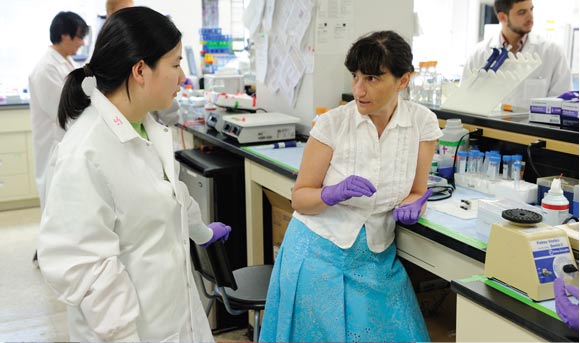
Human dwarfism, which is even depicted in ancient Egyptian art, is one of the oldest recorded birth disorders. The cause for the most common form, achondroplasia, has been known since the mid-1990s: Mutations in the fibroblast growth factor receptor 3 (FGFR3) gene produce proteins that cause disruptions in the growth of bones and cartilage. The question that remains: How does that happen, exactly?
That’s what Kalina Hristova wants to figure out. And as a professor of materials science and engineering at the Whiting School, she may have the perfect, if not traditional, skills to do it. Her lab is looking at the mechanics and physics, rather than the biology, of what happens in the cell membrane, where these errant proteins-and many other mutant proteins causing other diseases-reside. “Membranes matter because the membrane is the boundary between the cell and the outside world,” she says.
“Everything processed by the cell has to go through the membrane-not just actual molecules but also information. If something is on the outside, it can modify things inside the membrane, and a chain reaction can happen.”
It’s an unconventional kind of research, and Hristova is well suited to take it on. The daughter of an economist and a biomedical engineer, she says she never even thought about being anything other than a scientist. Hristova earned her undergraduate and master’s degrees in physics in her native Bulgaria, where a teacher assigned her a project involving cell membranes and she became intrigued by how physics concepts could be applied to biological problems. After earning her doctorate in engineering and materials science at Duke, she took a postdoctoral fellowship at the University of California, Irvine. There, she learned about dwarfism from a doctor and faculty member: “I realized that I could apply my background in materials science toward understanding the molecular basis behind the disorder,” she says.
The recipient of a federal stimulus grant in addition to her grant from the National Institutes of Health, she’s also engineering new tools to do her research. “The first problem is to understand at the molecular level what is happening at the membrane site,” she says. “But a lot of techniques are crude. By developing tools that were not available, we can answer questions nobody else can answer.”
Cell membrane proteins have been difficult to study because commonly used techniques, such as FRET (Förster resonance energy transfer) imaging, a microscope technology that uses fluorescence to measure protein interactions, does not allow for straightforward data interpretation. So Hristova developed a new FRET imaging method that allows researchers to quantify the protein interactions. Using these novel techniques, Hristova has disproved the common hypothesis that in dwarfism, the interaction between the proteins in the cell membrane has been altered. Instead, she and her lab team found that what is altered is the actual structure of those problem proteins in the membrane. Their findings were published in the Journal of Biological Chemistry in 2010.
Hristova, who came to Hopkins in 2001, researches the physics of cell signaling as well as membrane biology. In 2007, she won the Biophysical Society’s Margaret Oakley Dayhoff Award, which is given to a junior woman scientist of promise in the field of biophysics. She says that even when she’s traveling, her mind is always back in the lab, on her work. “We hope that the knowledge we gain will pave the way to the development of new cures.”




